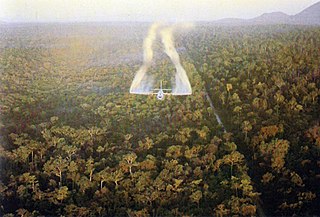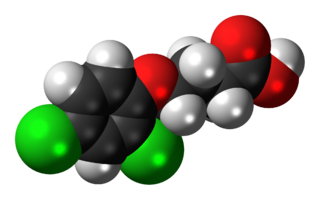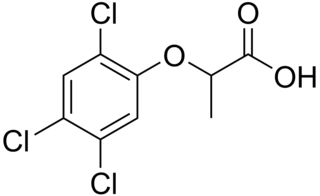 W
WAgent Green is the code name for a powerful herbicide and defoliant used by the U.S. military in its herbicidal warfare program during the Vietnam War. The name comes from the green stripe painted on the barrels to identify the contents. Largely inspired by the British use of herbicides and defoliants during the Malayan Emergency, it was one of the so-called "Rainbow Herbicides". Agent Green was only used between 1962 and 1964, during the early "testing" stages of the spraying program.
 W
WAgent Orange is a herbicide and defoliant chemical, one of the "tactical use" Rainbow Herbicides. It is widely known for its use by the U.S. military as part of its herbicidal warfare program, Operation Ranch Hand, during the Vietnam War from 1961 to 1971. It is a mixture of equal parts of two herbicides, 2,4,5-T and 2,4-D. In addition to its damaging environmental effects, traces of dioxin found in the mixture have caused major health problems for many individuals who were exposed, and their offspring.
 W
WAgent Pink is the code name for a powerful herbicide and defoliant used by the U.S. military in its herbicidal warfare program during the Vietnam War. The name comes from the pink stripe painted on the barrels to identify the contents. Largely inspired by the British use of herbicides and defoliants during the Malayan Emergency, it was one of the rainbow herbicides that included the more infamous Agent Orange. Agent Pink was only used during the early "testing" stages of the spraying program before 1964.
 W
WAgent Purple is the code name for a powerful herbicide and defoliant used by the U.S. military in their herbicidal warfare program during the Vietnam War. The name comes from the purple stripe painted on the barrels to identify the contents. Largely inspired by the British use of herbicides and defoliants during the Malayan Emergency, it was one of the so-called "Rainbow Herbicides" that included the more infamous Agent Orange. Agent Purple and Orange were also used to clear brush in Canada.
 W
WAgent White is the code name for a herbicide used by the U.S. military in its herbicidal warfare program during the Vietnam War. The name comes from the regulatory requirements of identifying each container of the various herbicides through the addition of colored stripes. Orange, purple, blue, and white were colors used by the manufacturers to ensure that the contents were easily identifiable in shipment and use. Colors were selected by the U.S. government. Largely inspired by the British use of herbicides and defoliants during the Malayan Emergency, it was one of the so-called "rainbow herbicides".
 W
WAminocyclopyrachlor is a selective, low-toxicity herbicide that provides pre- and post-emergent control of broadleaf weeds, woody species, vines and grasses on several non-food use sites, such as rights of way, wildlife management areas, recreational areas, turf/lawns, golf courses and sod farms. It was conditionally registered as Imprelis by DuPont in August 2010, and first used in Fall 2010. The chemical is a systemic herbicide and acts by disrupting gene expression. This causes undifferentiated cell division and elongation.
 W
WAminopyralid is a selective herbicide used for control of broadleaf weeds, especially thistles and clovers. It is in the picolinic acid family of herbicides, which also includes clopyralid, picloram, triclopyr, and several less common herbicides. It was first registered for use in 2005, in the USA under the brand name "Milestone" and later under various names starting with "Grazon". In the UK it is sold under the brand names Banish, Forefront, Halcyon, Pharaoh, Pro-Banish, Runway, Synero, and Upfront.
 W
WAuxins are a class of plant hormones with some morphogen-like characteristics. Auxins play a cardinal role in coordination of many growth and behavioral processes in plant life cycles and are essential for plant body development. The Dutch biologist Frits Warmolt Went first described auxins and their role in plant growth in the 1920s. Kenneth V. Thimann became the first to isolate one of these phytohormones and to determine its chemical structure as indole-3-acetic acid (IAA). Went and Thimann co-authored a book on plant hormones, Phytohormones, in 1937.
 W
WChloramben is a selective herbicide used to control the seedlings of broadleaf weeds and annual grasses. It is mostly used for soybeans, but also for dry beans, peanuts, sunflowers, peppers, cotton, sweet potatoes, squash, hardwood trees, shrubs, and some conifers.
 W
W4-Chlorophenoxyacetic acid or parachlorophenoxyacetate (pCPA) is a synthetic pesticide similar to chemicals in a group of plant hormones called auxins.
 W
WClopyralid is a selective herbicide used for control of broadleaf weeds, especially thistles and clovers. Clopyralid is in the picolinic acid family of herbicides, which also includes aminopyralid, picloram, triclopyr, and several less common herbicides. For control of creeping thistle, Cirsium arvense, a noxious, perennial weed, clopyralid is one of the few effective herbicides available. It is particularly damaging to peas, tomatoes, and sunflowers, and can render potatoes, lettuce, and spinach inedible. It does not affect grasses.
 W
WDicamba is a broad-spectrum herbicide first registered in 1967. Brand names for formulations of this herbicide include Dianat, Banvel, Diablo, Oracle and Vanquish. This chemical compound is a chlorinated derivative of o-anisic acid.
 W
W2,4-Dichlorophenoxyacetic acid is an organic compound with the chemical formula C8H6Cl2O3 which is usually referred to by its ISO common name 2,4-D. It is a systemic herbicide which kills most broadleaf weeds by causing uncontrolled growth in them but most grasses such as cereals, lawn turf, and grassland are relatively unaffected.
 W
W2,4-DB or 4-(2,4-dichlorophenoxy)butyric acid is a selective systemic phenoxy herbicide used to control many annual and perennial broad-leaf weeds in alfalfa, peanuts, soybeans, and other crops. Its active metabolite, 2,4-D, inhibits growth at the tips of stems and roots. It is classified in toxicity class III. It shows some evidence of toxicity to dogs and cats, such as changes in body weight and reduced numbers of offspring, when fed 25-80 milligrams per kilogram of body weight for prolonged periods. Tests of carcinogenicity in this range yielded differing results. It is moderately toxic to fish.
 W
WDichlorprop is a chlorophenoxy herbicide similar in structure to 2,4-D that is used to kill annual and perennial broadleaf weeds. It is a component of many common weedkillers. About 4 million pounds of dichlorprop are used annually in the United States.
 W
WFenoprop, also called 2,4,5-TP, is the organic compound 2-(2,4,5-trichlorophenoxy)propionic acid. It is a phenoxy herbicide and a plant growth regulator, an analog of 2,4,5-T in which the latter's acetic acid sidechain is replaced with a propionate group (with an extra CH3). The addition of this extra methyl group creates a chiral centre in the molecule and useful biological activity is found only in the (2R)-isomer. The compound's mechanism of action is to mimic the growth hormone indoleacetic acid (IAA). When sprayed on plants it induces rapid, uncontrolled growth. As with 2,4,5-T, fenoprop is toxic to shrubs and trees. The name Silvex was used in the USA but it has been banned from use there since 1985. According to the Environmental Protection Agency its greatest use was as a postemergence herbicide for control of woody plants, and broadleaf herbaceous weeds in rice and bluegrass turf, in sugarcane, in rangeland improvement programs and on lawns. Fenoprop and some of its esters were in use from 1945 but are now obsolete.
 W
WMCPA is a powerful, selective, widely used phenoxy herbicide. The pure compound is a brown-colored powder. MCPA has been extensively used in agriculture to control broad-leaf weeds as a growth regulator primarily in pasture and cereal crops field since 1945. The mode of action of MCPA is as an auxin, which are growth hormones that naturally exist in plants. Overdose application of MCPA acts as an herbicide and results in abnormal growth.
 W
WMCPB, 2,4-MCPB, 4-(4-chloro-o-tolyloxy)butyric acid (IUPAC), or 4-(4-chloro-2-methylphenoxy)butanoic acid (CAS) is a phenoxybutyric herbicide. In the United States it is registered for use on pea crops before flowering, for post-emergence control of broadleaf annual and perennial weeds including Canadian thistle, buttercup, mustard, purslane, ragweed, common lambsquarters, pigweed, smartweed, sowthistle, and morning glory. It has low to moderate acute toxicity, with kidney and liver effects as the main hazard concerns. It is not volatile, persistent, or likely to bioconcentrate.
 W
WMecoprop is a common general use herbicide found in many household weed killers and "weed-and-feed" type lawn fertilizers. It is primarily used to control broadleaf weeds. It is often used in combination with other chemically related herbicides such as 2,4-D, dicamba, and MCPA.
 W
WPicloram is a systemic herbicide used for general woody plant control. It also controls a wide range of broad-leaved weeds, but most grasses are resistant. A chlorinated derivative of picolinic acid, picloram is in the pyridine family of herbicides.
 W
WQuinclorac is a selective herbicide used primarily to control weeds in rice crops, but is also used on other agricultural crops and is found in some household herbicides for lawn use. Most lawn maintenance companies use the product for the control of annual grass weeds like crabgrass.
 W
W2,4,5-Trichlorophenoxyacetic acid, a synthetic auxin, is a chlorophenoxy acetic acid herbicide used to defoliate broad-leafed plants. It was developed in the late 1940s and was widely used in the agricultural industry until being phased out, starting in the late 1970s due to toxicity concerns. Agent Orange, a defoliant used by the British in the Malayan Emergency and the U.S. in the Vietnam War, was equal parts 2,4,5-T and 2,4-D. 2,4,5-T itself is toxic with a NOAEL of 3 mg/kg/day and a LOAEL of 10 mg/kg/day. Additionally, the manufacturing process for 2,4,5-T contaminates this chemical with trace amounts of 2,3,7,8-tetrachlorodibenzo-p-dioxin (TCDD). TCDD is a carcinogenic persistent organic pollutant with long-term effects on the environment. With proper temperature control during production of 2,4,5-T, TCDD levels can be held to about .005 ppm. Before the TCDD risk was well understood, early production facilities lacked proper temperature controls and individual batches tested later were found to have as much as 60 ppm of TCDD.
 W
WTriclopyr is an organic compound in the pyridine group that is used as a systemic foliar herbicide and fungicide.